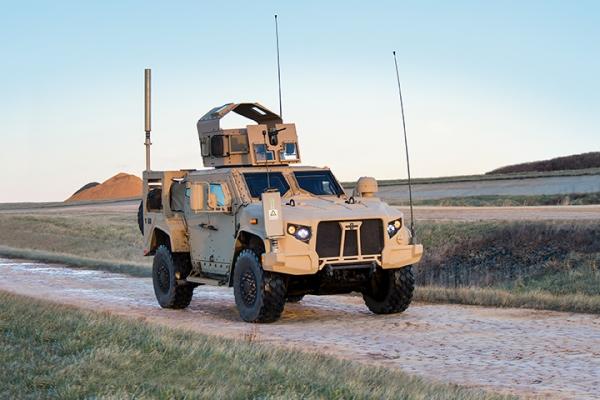U.S. Army maneuver officials are fine with the Joint Light Tactical Vehicle serving as the service's Light Reconnaissance Vehicle -- as long as it carries two more soldiers and a cannon more potent than the pre-World War II .50-caliber machine gun.
The service soon will begin fielding the JLTV to replace a large portion of the service's outdated Humvee fleet. Senior leaders have decided that the four-seat, armored vehicle will replace the Humvees used by scout platoons in light infantry units despite a multi-year push by maneuver leaders for a specialized Light Reconnaissance Vehicle.
Scouts need a vehicle designed specifically for their unit with enough firepower to destroy enemy recon formations, maneuver officials maintain.
Leaders from the Army Capabilities Integration Center and the Maneuver Center of Excellence are working with JLTV program officials to tweak the vehicle's design so it's more suited to reconnaissance units.
"It would have to carry six soldiers and a 30mm cannon," Lt. Gen. H.R. McMaster, director of ARCIC and deputy commanding general of Futures at Training and Doctrine Command, told Military.com.
The Army awarded Oshkosh Corp. a $6.7 billion contract last fall to build the first 17,000 production models of the JLTV. The Army and Marine Corps plan to buy a total of nearly 55,000 of the combat vehicles, including 49,100 for the Army and 5,500 for the Corps, to replace about a third of the Humvee fleets.
Gaps Exist
"The JLTV is a great vehicle. I mean it is a nice vehicle; it satisfies about 90 percent plus of what the Army wants extremely well," said Col. William T. Nuckols Jr., director of Mounted Requirements at the Maneuver Center of Excellence, or MCOE, at Fort Benning, Georgia.
"From MCOE's perspective, Gen. McMaster's and ARCIC's perspective, we are good with that, but there are some gaps that exist with the JLTV in a reconnaissance/scout platoon role," Nuckols told Military.com in an interview.
Scout platoons operate out ahead of larger combat units and need more firepower to deal with chance contact with a larger enemy force, maneuver officials maintain.
"That is going to get addressed regardless," Nuckols said. "We are working now on a medium cannon upgrade to the JLTV that will serve in that reconnaissance variant role."
No decisions have been made, but the cannon will be "similar to what the Apache has right now," the M230-LF 30mm cannon, Nuckols said.
"We may go a little bit smaller, but we obviously want something better than the 100-year-old .50 cal.," Nuckols said. "As Gen. McMaster likes to say, 'Currently when our scouts bump into the enemy ... it's a fair fight at best.' And we don't want a fair fight. Gen. McMaster likes to say, 'We want smoking boots on the other end.' "
There is "general agreement" in the Army for that improvement, and there has been money applied to a program that would buy about 2,000 of these cannons by the "early-to-mid-20s," Nuckols said.
Maneuver officials are also hoping to convince senior leadership, as well as Congress, that scout units need a larger variant of the JLTV, one that carries six soldiers instead of four.
The 6-by-36 Concept
The "6-by-36 concept" works out to six vehicles for every scout platoon of 36 soldiers, Nuckols said.
"With a four-seater, you would have to manage nine vehicles instead of six; it makes [it] a little more manpower intensive," he said.
A six-seater vehicle also increases the effectiveness of scout platoons, Nuckols said.
"You can increase the duration and number of dismounted patrols, you can increase the number and duration of dismounted observation posts," he said. "It allows you to increase the combination of leader to led ratios. They don't sound like much, but in the aggregate, the capabilities of that scout platoon increase pretty significantly.
Nuckols said he was surprised at how effectively scout platoons from 1st Brigade, 1st Cavalry Division, performed at the National Training Center in 2014 using the six-by-36 concept.
"We have collected a lot of data on the utility of that design," he said.
Maneuver officials have also looked at the Ground Mobility Vehicle as an alternative to developing a six-seat variant of the JLTV, an effort that is likely to take eight to 10 years, Nuckols said.
Special Operations Command in 2013 awarded a contract to buy about 1,300 GMVs. General Dynamics Corp. won the award with its Flyer Advanced Light Strike Vehicle, designed to carry seven passengers, weigh less than 7,000 pounds unloaded and be internally transported by a number of aircraft.
The GMV 1.1 likely will be presented as an alternative course of action to be used for scout platoons in units tasked with conducting forcible-entry operations, Nuckols said.
"Part of our job here is to develop courses of action," Nuckols said. "What we are trying to do is provide our senior leaders with options."
-- Matthew Cox can be reached at matthew.cox@military.com.
Related Video:



























